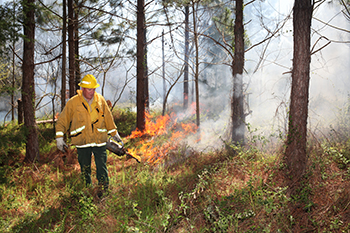Get Fired Up: Controlled Burns Help Manage Timberland

Drip torch in hand, forester Andy Guy sets off toward a longleaf pine stand. He’s on a mission — fire up the young plantation’s productivity.
Literally.
He’s igniting a controlled burn, which cleans up the understory, eliminates unwanted vegetation and allows fresh growth of grasses and vines attractive to wildlife like turkeys, deer and quail.
“A controlled burn is the most useful tool to give you the most immediate results when managing your land,” said Guy, an Alabama Forestry Commission (AFC) work unit manager. “It’s cost-effective, too.”
Controlled burns, also called prescribed fire, help landowners like Lamar Dewberry get the most bang for their buck when managing his 880 acres of timberland. It’s about one-fifth the cost of chemical applications, he said.
In addition to burning land before planting seedlings, the Clay County landowner burns tracts of longleaf pine every two-three years to control diseases and allow sunlight to seep into the stand. Longleaf is a more fire-tolerant pine that thrives on frequent fires after its first year, while loblolly pine is burned at a more mature age, around 15 years.
“I can’t imagine trying to manage timber without fire,” said Dewberry, a past Alabama TREASURE Forest Association president and current Alabama Tree Farm Committee chairman. “It allows longleaf to come out of the grass stage and grow upward. On an older stand, fire cleans the forest floor and gives potential for raking and baling pine straw.”
Dewberry dials into AFC’s resources to accomplish controlled burns, one of its many landowner-centric services.
AFC professionals help identify sensitive areas to exclude from the burn, like tree stands, trail camera locations and old home sites. They then identify conditions needed to achieve a landowner’s goal — including time of year, wind and moisture. Guy noted it’s critical the environment is dry enough to carry the fire through the stand.
Dormant season burns are lit in late winter, while early spring burns help landowners prime turkey habitats for hunting season. Older stands are burned from late spring into early summer.
Dewberry said he’s grateful for AFC’s resources, especially equipment to control the blaze if it jumps fuel-free fire breaks.
“If you don’t burn over a period of time, early successional species go away, and you end up with wax myrtle, bushes, sweet gum trees and other vegetation that’s unappealing to wildlife,” added Dewberry, who won the Alabama Natural Resources Council’s W. Kelly Mosley Environmental Award in 2018 with wife Felicia.
Routine burning also reduces natural fuel on the ground, which can help decrease the spread of wildfires. It’s a preventative measure that helps during seasons like 2016’s wildfire-riddled drought or could help control raging wildfires out West, said Alabama State Forester Rick Oates.
“Prescribed fire is an important tool in Alabama,” Oates said. “By using it throughout the life of a stand, you prevent the buildup of litter and other fuels that cause wildfires to quickly get out of control. It helps keep our forests safer and healthier.”
After a controlled burn, tree trunks and the ground are charred but quickly recover, Guy said. Bright green grass, vines and legumes spring up with warmer temperatures and rainfall.
“Controlled burning is a valuable practice for landowners,” Guy said. “Our goal is to ensure everyone who wants to burn finds a vendor or is able to use our resources to help manage their property.”
For all burns over 1/4 acre, permits are required. Permits are issued through AFC at (800) 392-5679. Learn more at forestry.alabama.gov.
